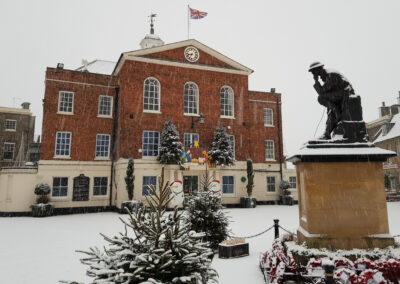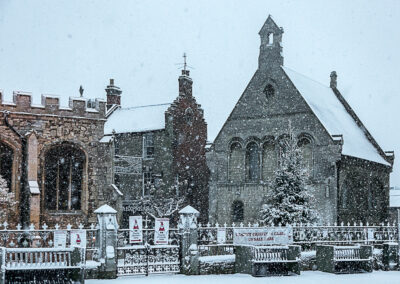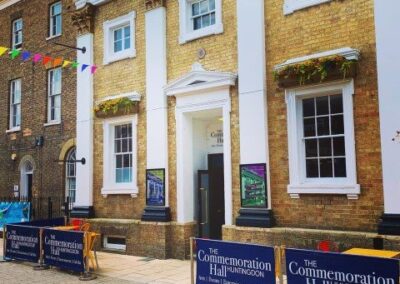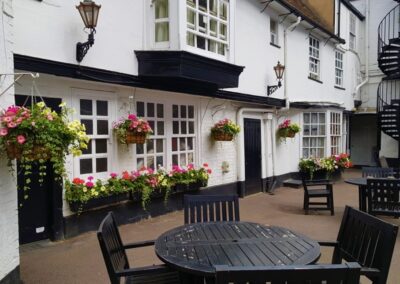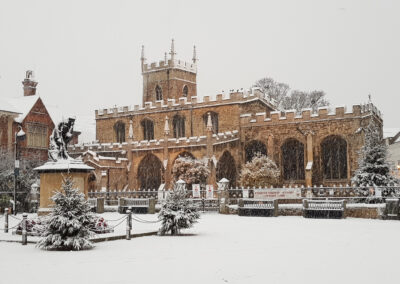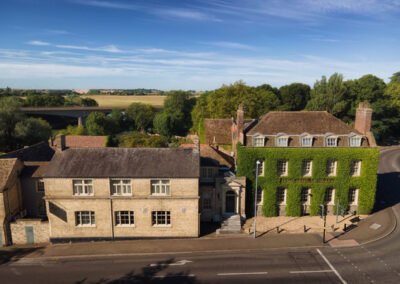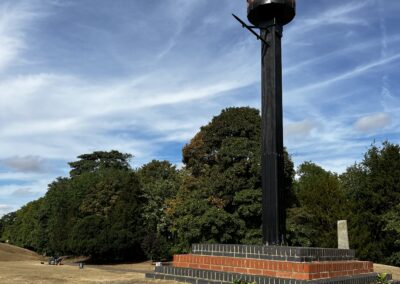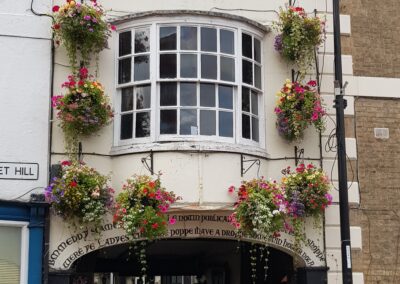The History of Huntingdon
The Iron Age to the Saxons
Evidence for Huntingdon’s origins is sparse. An Iron Age settlement has been found by archaeologists at Hinchingbrooke, but other than that there is little evidence of people living in the Huntingdon area. The main Roman town was Godmanchester, so it is unlikely that Huntingdon would have grown to any significant size during this period. The first mention of the town in a historical document is in the Anglo Saxon Chronicle, which refers to it as a ‘porte’ or market town. According to the Chronicle, Huntingdon was the main centre of Viking activity in the area. King Edward the Elder, son of Alfred the Great, successfully attacked the town in 921 and drove out the Vikings. He made Huntingdon the centre of its own administrative county. At this time Huntingdon was issuing its own money from the town mint. There is also archaeological evidence that the Saxons may have built a Minster at Huntingdon as well.
William the Conqueror
By the time of the Domesday survey in 1086, Huntingdon had 256 Burgesses and a population of around 2,000 people. William the Conqueror had ordered a castle to be built in Huntingdon – a typical wooden motte and bailey structure built in a commanding position overlooking the river. However, when William the Lion, King of Scotland and Earl of Huntingdon, rebelled against the Crown in 1174, Henry II himself came to Huntingdon, besieged the castle and ordered it to be destroyed. It was never rebuilt.
Town Charter
Huntingdon was granted its first charter by King John in 1205, which confirmed its borough status and allowed a weekly market. Nevertheless Huntingdon fell into economic decline during the Middle Ages, caused by the strength of competition from neighbouring towns like St Ives and Godmanchester. The coming of the Black Death to Huntingdon in 1348 almost finished off the town. Most of Huntingdon’s sixteen mediaeval churches fell into disrepair or disappeared completely. When the English antiquarian and topographer John Leland visited Huntingdon during the 1530s he noted just four churches left in the borough.
The Cromwells
Henry VIII’s dissolution of the monasteries in the 1530s threatened the economy of many towns, but the wealth of institutions like Ramsey Abbey passed into private hands and created a new secular aristocracy. The Cromwell family were the main beneficiaries in Huntingdonshire, and they made their home at Hinchingbrooke, on the site of the former nunnery. The Cromwells were high in the favour of the crown, particularly after the lavish entertainment offered to King James I at Hinchingbrooke on his royal progress south in 1603.
It was a minor member of the Cromwell family, Oliver, born in Huntingdon in 1599, who was to become the town’s most famous son. He took part in the town’s political life, and was elected MP for Huntingdon in 1626, but he became embroiled in a bitter political dispute over the proposal for a new royal charter which would have ended the need for elections in the town. King Charles I went ahead and granted Huntingdon its anti-democratic new charter in 1630. Cromwell sold much of his property in Huntingdon and moved to St Ives in the following year. When he returned to his birthplace in 1643 it was as a colonel in the Parliamentary army.
Civil War 1645
Huntingdon saw some military activity during the Civil War. On 24th August 1645 a Royalist force took the town after a short skirmish. King Charles I himself entered Huntingdon, but he and his army left on 26th August as a Parliamentary force approached, before any serious fighting could begin. A few years later the King was dead and Oliver Cromwell was ruling the country in his place.
Georgian Architecture
The town we see today is largely a Georgian creation. Huntingdon prospered in the eighteenth century due to its advantageous position as a coaching stop on the turnpike road north from London. Huntingdon’s inns flourished and the town became fashionable, with coffee shops and book clubs. Balls and assemblies were held in the new Town Hall, rebuilt in 1745. The coming of the railway in 1850 brought the end of the coaching trade, but it did little to halt Huntingdon’s expansion. The Victorian era saw the building of schools and houses as well as the workhouse and the towering Trinity Church.
WW1
Huntingdon played its part during the First World War. Soldiers were billeted in the town throughout the war. Shops and businesses closed as local men went off to war and food shortages were common. Walden House became a Red Cross hospital and treated almost 4,000 patients before it closed in 1919. In 1923 the Thinking Soldier war memorial was unveiled in Market Hill, to remember the men of Huntingdon who gave their lives.
WW2
The story was the same during the Second World War – rationing and fund-raising began again, and Hinchingbrooke House became a hospital. Evacuees from London and refugees from Europe arrived in Huntingdon, as did the European and American forces, the latter of whom have maintained their presence in military bases around Huntingdon ever since.
The Modern Era
The Town Development Act of 1952 provided the impetus for the next phase in Huntingdon’s growth. Ambitious plans to attract new residents from London were made, and building on the new Oxmoor estate began in 1960. The Chequers Court shopping centre was built to modernise the town centre and now a major redevelopment is planned there, with new retail units and a multi storey car park to enhance the town. An increase in population from 6,500 in 1961 to 15,000 in 1974 put huge pressures on local roads, and a bypass was finally opened in 1975.
During the 1980s Huntingdon was the fastest growing town in the fastest growing county in the whole country. This prosperity was further enhanced when Huntingdon’s former MP, John Major, became Prime Minister in 1990. Local industry flourished, and the building of the Towerfields Leisure Park has made Huntingdon a commercial focus for the district.
The town celebrated its rich and varied history with events such as The Cromwell quarter centenary in 1999, the Pepys weekend in 2003, the celebration of Huntingdon 800 in 2005, and the Huntingdon Heritage weekend in 2010.
Caroline Clifford and Alan Akeroyd,
authors of Huntingdon: Eight Centuries of History (Breedon Books, 2004)

